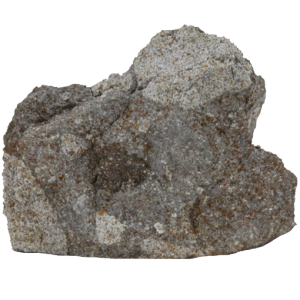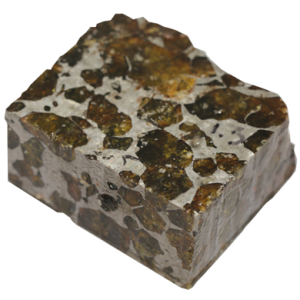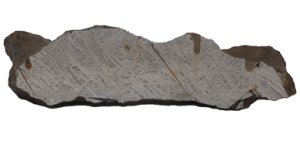What is a meteorite?
Put simply, a meteorite is a rock that formed within a planetary body other than the Earth and, through a series of cosmic chances, crossed the path of the Earth’s orbit and struck its surface. This is not to be confused with a meteor, which is the visual phenomenon observed when extraterrestrial material ionizes gases as it enters the atmosphere at an astronomical speed (you might know it as a shooting star). Prior to entering the atmosphere, a meteorite would be termed a “meteoroid.”
Why do we study meteorites?
Researcher’s answer: Because they’re AWESOME.
Practical answer: We study meteorites for a variety of reasons. Meteorites are a window into the early evolution of planets and other bodies in our Solar System. Much of what we know about the origin of the Earth and the other planets is founded in our understanding of meteoritics (the study of meteorites). Their ages, bulk composition, and formational history can tell us much about the history of the Earth, and also provide us with a baseline for understanding geologic processes today. Much of that knowledge has been lost on Earth, due to subsequent geologic processes that effectively erase our earliest history. The foundational knowledge we can establish with meteorites is not only of use to academics and researchers, but can also impact our understanding of resource extraction and natural hazards. As our global society makes the transition to a space-faring one in the near future, an understanding of space resources will be critical in establishing efficient and sustainable infrastructure, as well. Currently, space exploration is prohibitively expensive for resource prospecting, so studying the meteorites that could represent future potential resource reservoirs is the most practical method for establishing a knowledge base.
Where do meteorites come from?
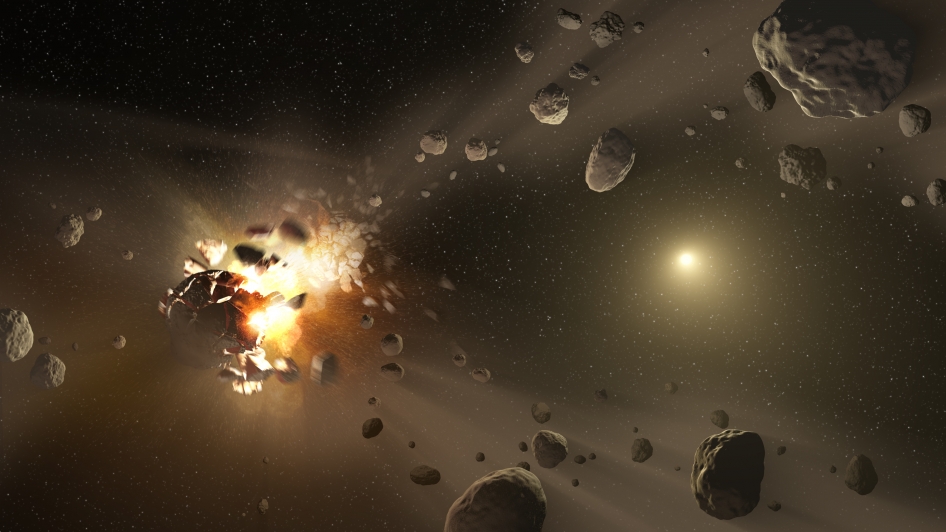
Asteroids forming in the asteroid belt between Mars and Jupiter. Image Credit: NASA/JPL-Caltech
Most meteorites are fragmented pieces of asteroidal material, which originated in the asteroid belt between Mars and Jupiter. Collisions between asteroids generate enough force to break the bodies into fragments, some of which get redirected toward Earth due to the interplay between the gravitational forces of Jupiter and the Sun.
The majority of meteorite groups do not have a particular “parent” body to which they can be attributed. For some, it may be that their source was completely destroyed by impacts, leaving nothing for us to find. For others, we simply do not yet have the data to positively identify a parent body. Recently, endeavors such as NASA’s Dawn mission (with the input of the meteoritics community) have reinforced the theory that the HED clan of meteorites formed within the asteroid 4-Vesta. Learn more about NASA’s DAWN Mission.
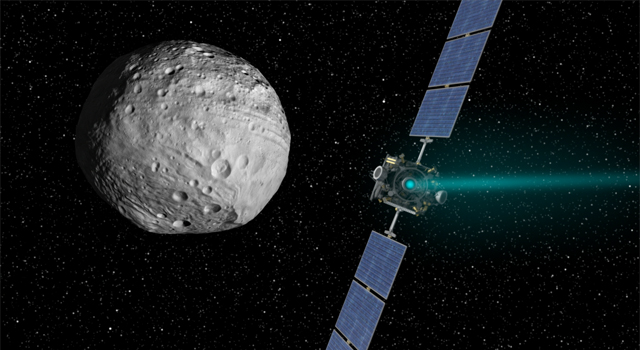
Dawn spacecraft orbiting 4-Vesta. Image Credit: NASA/JPL-Caltech
Some meteorites actually represent material from the surface of the Moon and Mars. These fragments were liberated from the surfaces of their respective bodies by impact, only to find their way to the Earth. We can recognize the origin of these rocks by examining their ages and geochemical properties, then comparing them to data gathered by exploratory missions such as NASA’s 1976 Viking mission (Mars) and manned missions to the Moon, such as the Apollo and Luna missions.
What kinds of meteorites are out there?
We can break meteorites up into three broad categories:
Stony Meteorites
These are made up of mostly rock-forming (silicate) minerals. We further classify stony meteorites into two types: chondrites and achondrites.
Chondrites represent the earliest-formed solid material in the Solar System, and have remained relatively unchanged for the last 4.56 billion years. These meteorites contain CAIs (calcium and aluminium-rich inclusions), which have been dated as the oldest solid matter in the Solar System. Chondrites derive their name from the small spherical structures of which they are composed, chondrules. These structures are also believed to have condensed from the Solar Nebula, a disc of swirling hot gas that surrounded the early Sun. Currently, it is thought that all solid material in the Solar System is derived from this primitive chondritic material. See sample.
Achondrites represent chondritic material that has been altered by igneous and metamorphic processes. As the name implies, achondrites lack the chondrules found in chondrites (“a” is a latin prefix meaning “without”). As large enough bodies of chondritic material accumulated, they were able to generate and retain enough heat (through processes such as radioactive decay) that the original material melted and recrystallized through a process known as differentiation. Differentiation results in an Earth-like structure, with to internal layering: a central metal core, an intermediate layer known as the mantle, and a surface crust. Stony achondrites derive from the mantle and crustal layers of these differentiated bodies. See Sample.
Primitive Achondrites provide further evidence for the connection between chondrites and achondrites, as some still contain relict chondrules and a chondritic composition.
Stony-Iron Meteorites
These are composed of a mixture of metals and silicate minerals. The history of stony-iron meteorites remains unclear, but the composition of stony-iron meteorites may be explained if they formed either at the core-mantle boundary of their parent bodies or if they were produced from violent collisions that mixed crust and mantle material with metals originating in the core. Stony-iron meteorites include pallasites (see sample) and mesosiderites (see sample).
Iron Meteorites
These are composed chiefly of metallic iron-nickel alloys. They represent material sourced from the cores of differentiated parent bodies. Much of what we know of the chemical composition of Earth’s core has been inferred from studies of iron meteorites – we can’t get to the Earth’s core with modern technology, but iron meteorites offer the best analogues for studying the processes of differentiation that facilitated the evolution of Earth’s layered structure. The meteoritic record contains a disproportionate number of iron meteorites to those that have actually been observed to fall. This is because iron meteorites are generally the easiest meteorites to identify in the field. See Sample.



